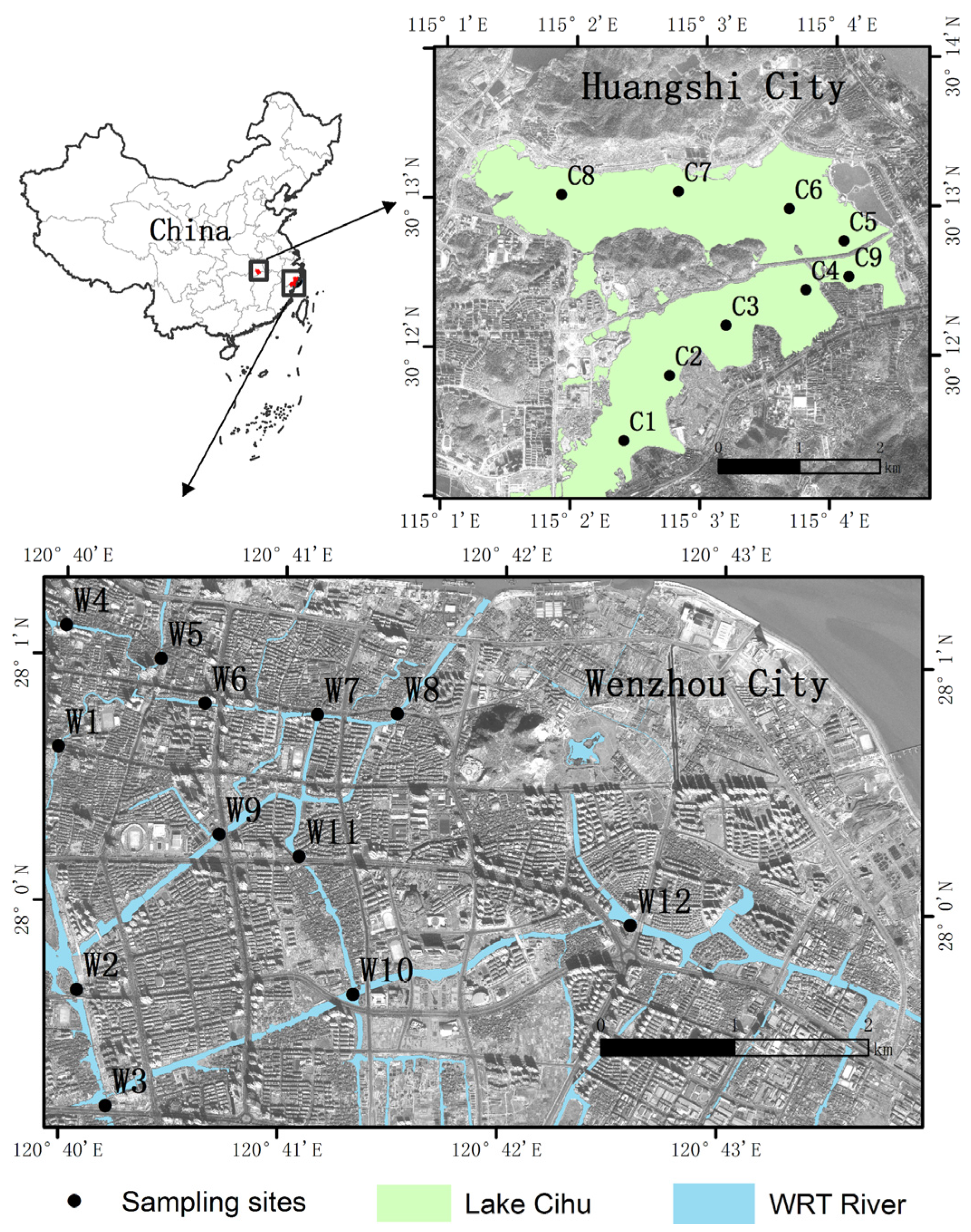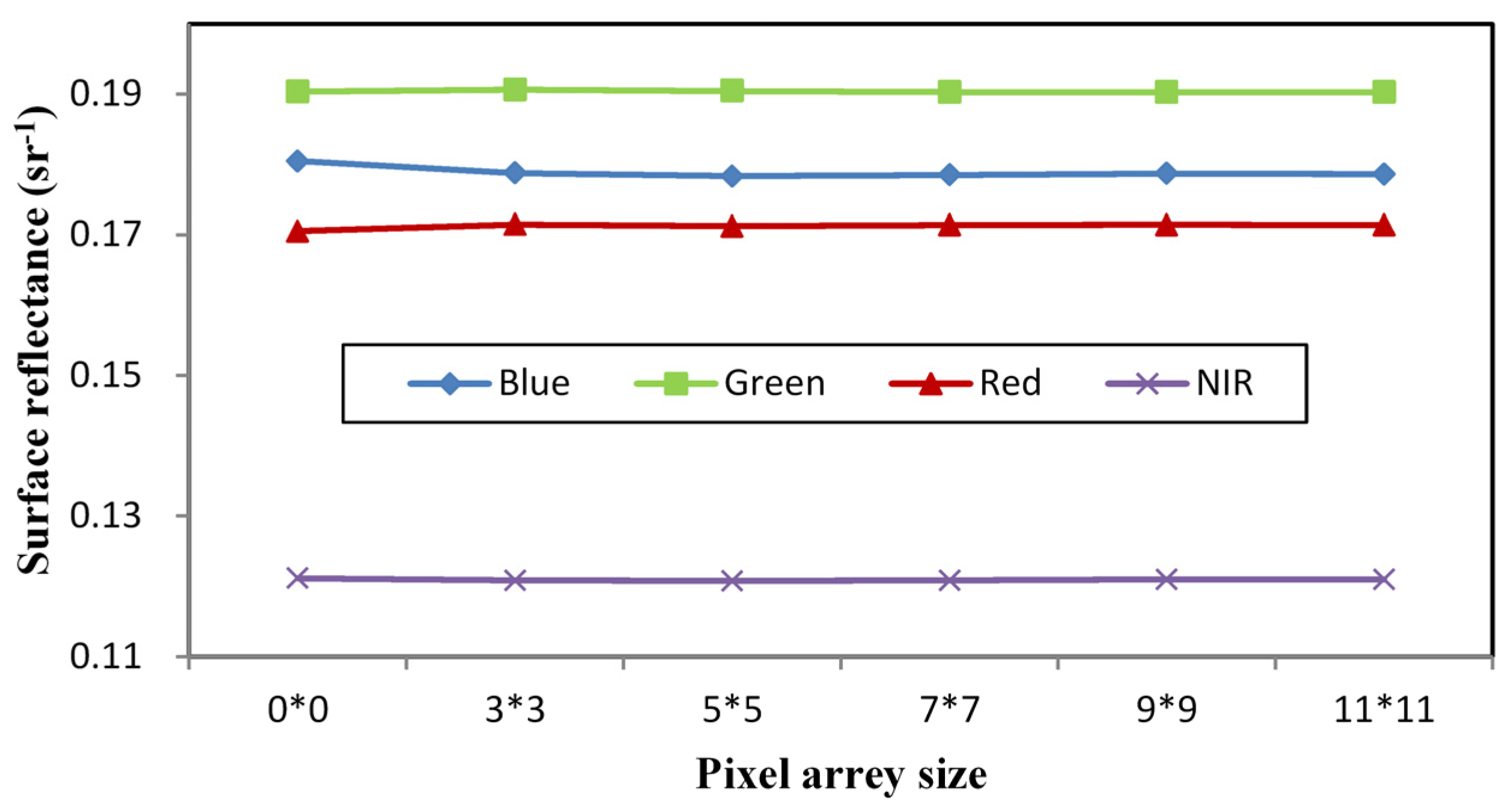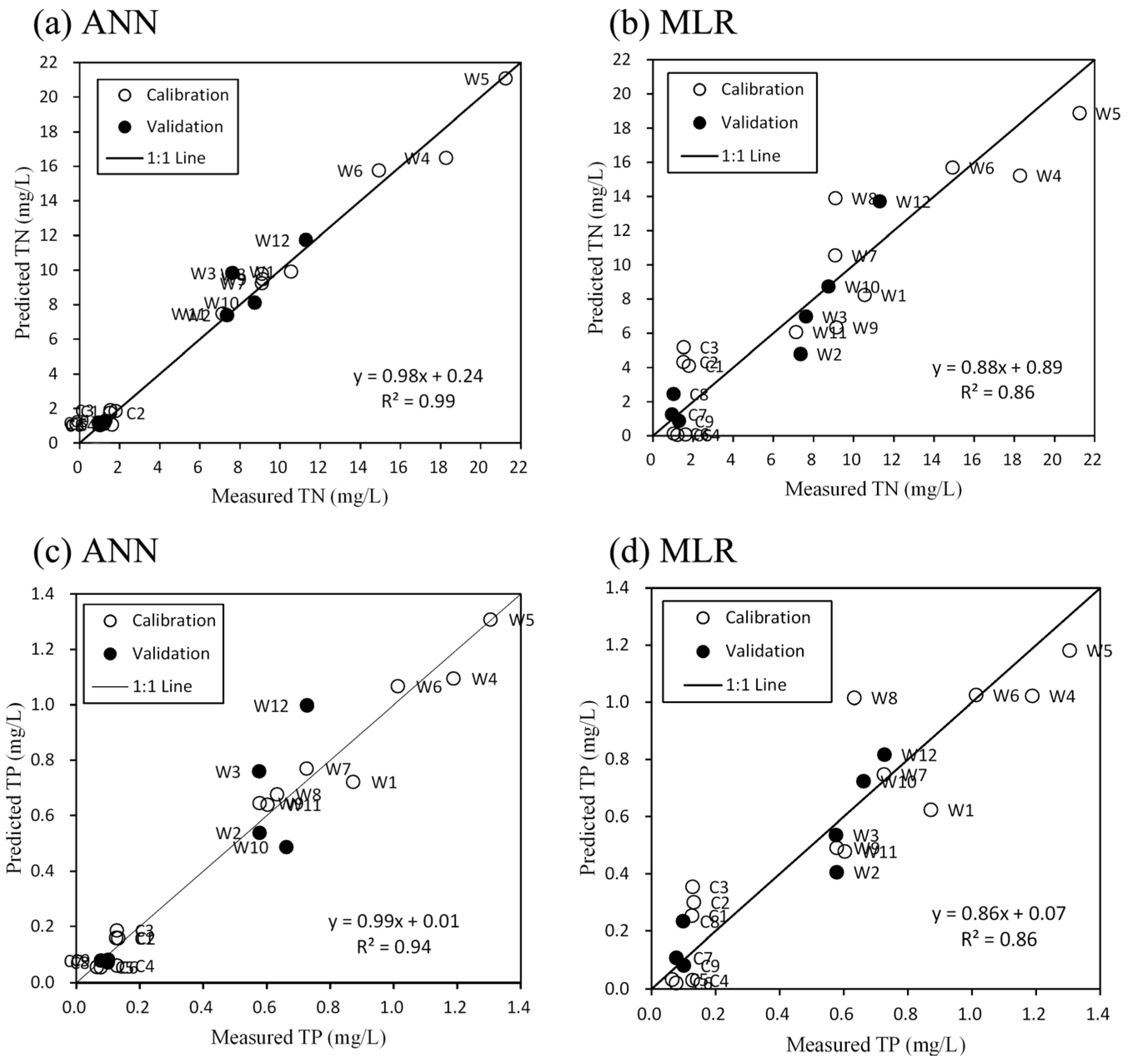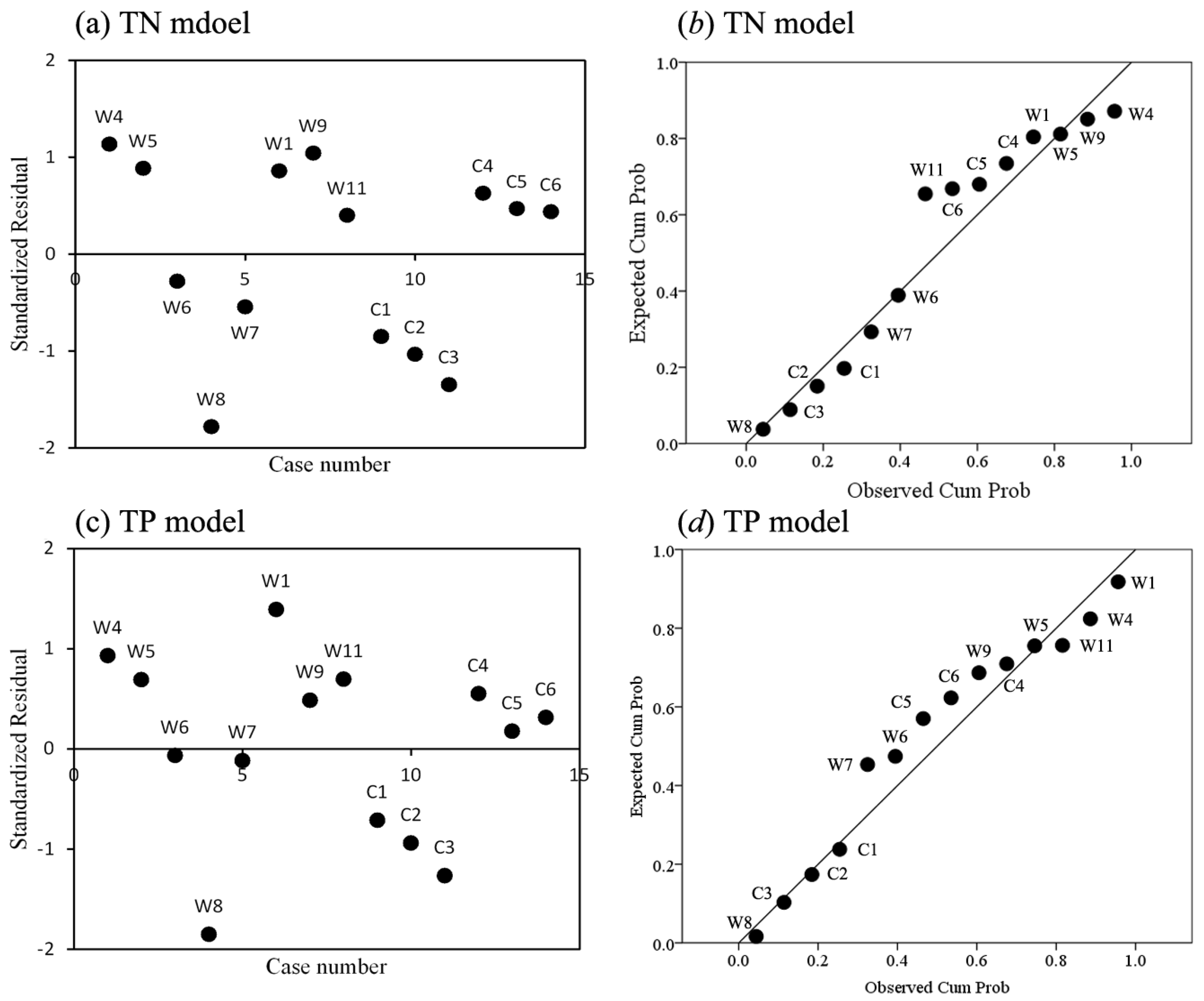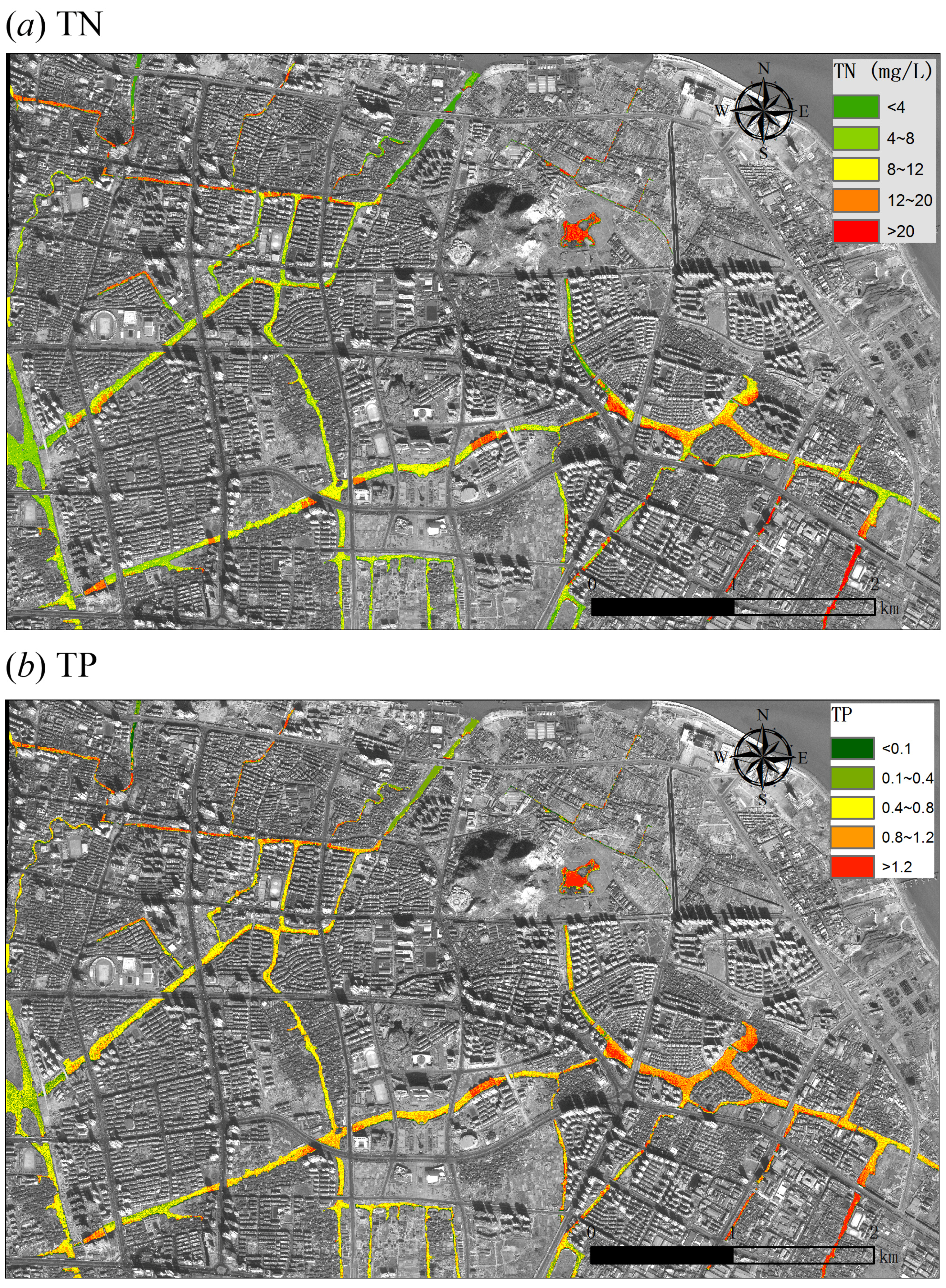1. Introduction
Urbanization has become a ubiquitous global change over the 20th century [
1]. As a “living laboratory” in urbanization [
2], China has experienced rapid economic development and urbanization in the past three decades. Rapid urbanization in China has resulted in widespread surface water eutrophication and water quality degradation because of the lack of sanitation and uneven distribution of water treatment facilities compared to most developing countries [
3]. The fact that 90% of urban waterways are classified as heavily polluted has raised great concerns about human and aquatic ecosystem health [
4,
5].
Monitoring water quality is the first step toward understanding the characteristics of water pollution and devising effective mitigation strategies. Traditionally, water quality parameters (WQPs), such as total nitrogen (TN) and total phosphorus (TP), are obtained by routine monitoring methods of field sampling and laboratory analyses [
6]. In addition to cost and labor intensiveness, these traditional approaches are not suitable for monitoring a large number of water bodies at a regional or national scale because of spatial heterogeneity and temporal changes of water quality across aquatic ecosystems. This condition is especially true for urban lake and river systems, where numerous point and non-point inputs occur over relatively short distances [
4]. With the constant development of environmental information technology, remote sensing plays an important and effective role in water quality monitoring because of its wider coverage, higher efficiency, and lower cost than traditional sampling methods. Sensors aboard satellites with a wide variety of spectral, spatial, and temporal resolutions have been used to access several water quality parameters. Because the optical properties of water depend on the concentration and character of total suspended sediments (TSS), phytoplankton (typically estimated by chlorophyll-a measurements), and chromophoric dissolved organic matter (CDOM), numerous studies, e.g. [
7,
8,
9], have previously demonstrated the application of satellite remote sensing to monitor these three water quality parameters. Of all pollutants, nitrogen (N), which is needed for protein synthesis, and phosphorus (P), which is needed for DNA, RNA, and energy transfer, are both required to support aquatic plant growth and are the key limiting nutrients in most aquatic and terrestrial ecosystems [
3,
10,
11].
The goal of this study is to develop a set of algorithms to detect TN and TP concentrations in urban water bodies in China, based on the remote sensing technology. Two primary questions are addressed to achieve such goal: (1) Can TN and TP concentrations be assessed using satellite imagery data? (2) Are the satellite sensors used in previous studies applicable to small area urban water bodies? Many scientists (
Table 1) have made continuous efforts to answer the first question, even though correlating remote sensing spectral features directly to nitrogen and phosphorus concentrations of water bodies in theory is difficult.
Table 1.
Previous studies on retrieving TN and TP concentrations of water bodies.
Table 1.
Previous studies on retrieving TN and TP concentrations of water bodies.
| Reference | Site | Model | Spectral Regions Used | WQP | R2 |
|---|
| Kutser et al. [12] | Lake Peipsi, Estonia | Simple linear model | 415–455,655–685, and 405–605 nm of in situ | TP | 0.87 |
| Li et al. [13] | Pearl River estuary, China | Multivariate linear model | Band 1–Band 6 of SeaWiFS | TIN | 31.9% (MRE) |
| Lei et al. [14] | Lake Taihu, China | Multivariate linear model | Band 2–Band 4 of CBERS-1/CCD | TN | 12.2% (MRE) |
| Wu et al. [15] | Qiantang river, China | Multivariate linear model | Band 1–Band 3 of Landsat/TM | TP | 0.77 |
| Pan et al. [16] | Lake Chaohu, China | Improved multivariate linear model | B72, B79, and B97 of HJ1A/HIS | TN | 0.76 |
| Song et al. [17] | Lake Chagan, China | Multivariate linear model | Band 1–Band 3 of Landsat/TM | TP | 0.63 |
| Artificial Neural Network model | Band 1–Band 4 of Landsat/TM | 0.94 |
| Chebud et al. [18] | Kissimmee River, USA | Artificial Neural Network model | Band 1–Band 7 of Landsat/TM | TP | 0.95 |
| Torbick et al. [19] | Lower Peninsula of Michigan, USA | Multivariate linear model | Band 1–Band 3 of Landsat/TM | TP | 0.65 |
| Band 1 and Band 3 of Landsat/TM | TN | 0.75 |
| Chang et al. [20] | Tampa Bay, FL, USA | Genetic programming model | Band 1, Band 3, and Band 4 of MODIS | TP | 0.58 |
| Sun et al. [21] | Lake Taihu, Chaohu, Three Gorges Reservoir, and Dianchi, China | Type-specific SVR model | Rrs (559)–Rrs (769) of HJ1A/HIS | TP | 0.71 |
Several studies have used indirect retrieval methods to estimate TN and TP concentrations based on the study that they are closely correlated with other water quality parameters, such as TSS, chlorophyll-
a (Chl-
a), or CDOM [
13,
18]. As an inference, this study assumes that TP and TN concentration has an indirect correlation with the optical properties of water, which can be retrieved by satellite imagery. Wu
et al. [
15] developed an indirect model in the form of Reflectance = f[Chl-
a(TP),SD(TP)] from Landsat Thematic Mapper (TM) band1, band1/band3, and band3/band2. Song
et al. [
9] combined a genetic algorithm and partial least square (GA-PLS) to retrieve TP concentration for three Indiana water supply reservoirs based on the close relationship between TP and TSS and Chl-
a and Secchi depth (SD). Pan
et al. [
16] established an inversion model of TN by multivariable regression Kriging to analyze the close association of TN and Chl-
a or TSS by HJ-1A/HSI (hyperspectral image) satellite imagery. Some other studies have achieved good retrieval accuracy by directly exploring the relationship between TP and TN concentrations, and satellite image data by establishing empirical models [
14,
18,
19]. According to the literature (
Table 1), the methods could generally be divided into two categories: traditional linear regression model and intelligent algorithms. In recent studies, intelligent algorithms such as artificial neural network (ANN) [
6,
17,
22,
23] and support vector machine (SVM) models [
21,
24,
25] have been increasingly used in this field. Therefore, a traditional multiple linear regression (MLR) model and an ANN model are chosen to estimate TN and TP concentrations of urban water bodies in China.
Few studies have found answers to the question of whether satellite imagery can successfully be applied to the remote sensing of water quality in urban water bodies of small area. Most studies focused on lakes and rivers with larger spatial scale. Among these studies, the imagery from Landsat/TM sensors was most commonly applied in the estimation of water quality parameters [
15,
19,
22,
26,
27,
28]. However, the 30 m spatial resolution of Landsat/TM imagery is not suitable for the narrow width and small area of urban water bodies, especially urban rivers. Therefore, higher resolution satellite is necessary to determine water quality of small urban water bodies. IKONOS imagery has four multispectral bands similar to Landsat/TM bands 1–4 and high (4 m) spatial resolution, making it a good candidate for applying previous methods to assess smaller lakes and ponds [
29,
30]. Currently, only a few studies have used the high spatial resolution satellite imagery such as IKONOS to monitor water quality. For example, Sawaya
et al. [
31] showed a strong relationship (
R2 = 0.89) between water clarity dataset and spectral-radiometric response of IKONOS data. Ekercin [
32] used the IKONOS multispectral data to determine SD, Chl-
a, and TSS in Gold Horn, Istanbul; the measured and estimated values of all three water quality parameters are in good agreement (
R2 > 0.97). Shamis [
33] developed empirical models using linear regression analysis to retrieve Chl-
a, TSS, and TP concentrations in the Sazlıdere reservoir, Turkey by IKONOS imagery, and produced a commonly good performance with
R2 ranging from 0.65 to 0.98. These studies show the potential application of IKONOS in the field of remote sensing of water quality; however, few studies have applied IKONOS imagery to directly determine TN and TP in small urban water bodies.
This study took Lake Cihu (Huangshi, China) and the lower reaches of Wen-Rui Tang river (Wenzhou, China) as examples to (1) evaluate the ability of IKONOS imagery data for determining TP and TN in urban water bodies, (2) estimate the TP and TN concentration in Lake Cihu and lower reaches of Wen-Rui Tang (WRT) River using regression and ANN models, (3) compare the performance between the models using in situ data, and (4) map TP and TN concentrations using the best model and IKONOS imagery data. The purpose of this paper is to present a cost-effective method to monitor TP and TN in urban water bodies while significantly reducing sampling time.
2. Study Area
The selected areas for this study are Lake Cihu, an urban lake in Huangshi city, and the lower reaches of WRT River, an urban river that crosses Wenzhou city (
Figure 1). These two urban water bodies represent two cities, which have different levels of urbanization and are separated by a long distance. These two urban water bodies are chosen to improve the universality of the methods used in this study. Lake Cihu is located in the northeast of Huangshi city along the southwestern bank of one of the major bends in the Yangtze River. It covers an area of approximately 9 km
2 from 30°10′46.71″ N to 30°13′22.50″ N in latitude, and 115°01′7.44″ E to 115°04′34.58″ E in longitude. It has a catchment area of 62.19 km
2, an average depth of 1.75 m, a shoreline of 38.5 km, and is connected to the Yangtze River by Shengyang sluice gate. The lower reaches of WRT River run through an urban district in Wenzhou City, a metropolitan area with a population of about seven million. This area has a catchment area of about 28 km
2 from 27°59′6″ N to 28°1′20″ N in latitude, and 120°39′56″ E to 120°43′50″ E in longitude. More than 75% of the watershed consists of a flat alluvial plain with elevations ranging from 3.0 to 4.2 m [
4]. The average width of the urban portion of the WRT River is about 50 m, with a range from 8 to 150 m.
Figure 1.
Location of study areas and sampling sites.
Figure 1.
Location of study areas and sampling sites.
Considering their geographic features, the two urban water bodies play an important role in their respective cities. Lake Cihu is one part of Huangshi Riverside Business Central Axis. The WRT River is the “mother” river supporting the city for transportation, aquaculture, agriculture, drinking water, and other aspects of daily life. However, with the rapid industrial growth and urbanization in recent years, the cities have generated large volumes of untreated sewage and urban runoff pollution, which are discharged directly into the lake and river systems. The two urban water bodies do not currently meet the Type V national water quality standards [
34], which is the lowest water quality standard that supports aquatic ecosystem health [
35,
36]. Therefore, effectively monitoring the TN and TP of the two urban water bodies has become a serious task.
6. Discussion
The aim of this study is to retrieve TN and TP concentrations of relatively small urban water bodies by satellite images. Previous studies mainly focused on large spatial scale water bodies, such as Lake Taihu (2338 km
2), Lake Chaohu (789 km
2), and Qiantang River (about 150–500 m wide). As a result, the moderate-resolution imaging spectroradiometer (MODIS) with 250 m spatial resolution and Landsat/TM with 30 m spatial resolution have been widely applied to determine TN and TP concentrations [
14,
15,
16,
19,
21,
47]. However, the low spatial resolution remote sensing images provided by the abovementioned satellite sensors are not applicable to small-scale urban water bodies, especially urban rivers several meters wide. To solve this problem, high spatial resolutions IKONOS multispectral imagery, which has four multispectral bands similar to Landsat/TM bands 1–4 and 4 m spatial resolution, is used in this study. The statistical analysis reveals that both MLR and ANN models have highly accurate inversion results for TN and TP concentrations. This good performance demonstrates that the IKONOS satellite data has adequate potential to determine TN and TP concentrations in urban water bodies at a relatively small scale.
Another advancement made in this study is to establish two inversion equations to retrieve both TN and TP from urban water bodies. Compared to the existing TN and TP inversion equations shown in
Table 1, these two equations (Equations (3) and (4)) have relatively simple forms and only require a single band instead of band ratios in the right-hand side because of high correlations between IKONOS bands and
in situ TN and TP data. Three possible reasons for this condition are considered, as follows:
- (1)
The commercial satellite has limited image archives across the study area because of the lack of research using the IKONOS images in the area. As a result, little IKONOS image data are available to correlate with the in situ TN and TP concentrations.
- (2)
The spatial detail of high-resolution IKONOS images is impressive. However, the problem of spectral-radiometric similarity between certain classes is compounded. Mixed pixels are still present, and the variability within classes may be greater than in lower-resolution images [
29]. The resulting high-interclass and low-interclass variability may lead to a reduction in the statistical separability of the different classes in the spectral domain. This characteristic of IKONOS images may be one factor that differentiates it from the images of middle and low spatial resolution satellites, such as MODIS and Landsat/TM. To overcome this inadequacy and complement the spectral feature space, textural, structural, scale, and object-based features should be effectively exploited in future studies.
- (3)
Several studies [
48,
49,
50,
51] revealed that lake or river water quality is highly dependent on the landscape characteristics with respect to watershed and geographical scales. Therefore, the difference in water quality configurations between urban water in this study and the large lakes and rivers examined in previous studies may lead to the differences in the relationships of surface reflectance and TN and TP concentrations.
For optically shallow water, water quality parameters can be usually interferential because of the bottom disturbance [
52,
53]. Lake Cihu is shallow with water depth ranging from 0.72 to 5.73 m; however, water with average turbidity of more than 34 NTU (Nephelometric Turbidity Unit) is too turbid to see the bottom, even when water is near the shore. It can be considered as optically deep water. The contribution from the bottom of optically deep water has little effect to the intensity and spectral distribution of remotely sensed signal above the water surface [
52,
54]. Therefore, the potential backscattering issues from the lake bottom were not considered in this study. However, in some very shallow locations, the potential backscattering issues from the lake bottom may bring some errors, and the estimated TN and TP concentrations may not be very reliable. Under these circumstances, incorporating additional information on water depth, such as bathymetric data, would be better in the modeling activities to avoid any misinterpretation of the results.
Like in many other studies [
6,
15,
17,
21], all water samples and the two images collected are considered as the dataset. About 70% of the water samples, which are six samples from one water body and eight samples from the other water body, have been chosen to calibrate the models. The other seven water samples were used to validate the models. The approach of selecting data subsets used in this study can improve the performance of models, but may reduce the generalization ability of the models. In future studies, a variety of strategies for selecting data may be considered to calibrate and validate the models. For example, one image and its corresponding measured data can be used to calibrate models, and the other image and data are used for validation. Furthermore, some cross-validation methods like random forests (RF) can be considered.
The statistical analysis of
R2 and RMSE, achieved by both linear (MLR) and nonlinear (ANN) models, supports the hypothesis that the relationships between reflectance and water quality parameters concentration are nonlinear, which is consistent with the conclusions in previous studies [
6,
17,
32,
41,
55]. Though the results demonstrate that the ANN model has a stronger ability to simulate the complex nonlinear relationship, it may be more prone to the effects of the local optimal solution developed on the basis of the empirical risk minimization theory [
56]. In this study, two processing methods,
i.e., data normalization and setting different hidden layer neurons, are applied in training the ANN model to overcome the network overfitting problem. However, the estimation accuracy for the TP validation data subset is still lower than the linear regression analysis. This unfavorable situation may be improved by new studies using other advanced intelligent methods, such as SVM and GA-PLS to obtain better-fitting results.
In
Figure 5 and
Figure 6, TP and TN concentration maps show that water quality near the residential and industrial areas is worse, most likely because of pollutants from domestic sewage and industrial wastewater. The Cihu map and previous reports [
35,
57] show many intensive residential quarters and several sewage plant outlets in the south of Lake Cihu, which contribute to high concentrations in the southern part of the lake. The main urban areas with highly-intensive residential area, where the WRT River flows through, can be seen clearly in the satellite image. TP and TN concentrations in the main stream from the rural zone are lower than that in tributary across the residential area. These observations are consistent with the results of previous studies [
36,
58].
This study reveals that degraded water quality is related to both anthropogenic activities and poor wastewater management. The two cities examined in this study have different levels of urbanization. Wenzhou, where WRT River flows through, is highly urbanized and is one of China’s most developed areas. By contrast, Huangshi (where Lake Cihu lies) is located in the middle of China and urbanization is currently relatively low. However, Huangshi’s urbanization course has greatly accelerated during recent years. Both Lake Cihu and the lower reaches of WRT River have become the main receivers of wastewater from their respective cities because of the lack of sanitation and uneven distribution of water treatment facilities during the urbanization process. These two urban water bodies indicate that the trends of TN and TP concentrations are very consistent in all of the water areas shown in
Figure 8. By analyzing all
in situ and water pixels data, we determine that TN and TP concentrations of the lower reaches of WRT River are about 8 to 12 times higher than those of Lake Cihu, thereby reflecting the effects of higher level of urbanization. However, a potential relationship has been found, in which the TN/TP ratios of Lake Cihu and the lower reaches of WRT River are very close. Therefore, the chemical compositions of these two urban water bodies are expected to be similar, which could lead to similar spectral distribution of remotely-sensed signal above water surface. If the chemical compositions of urban water polluted by industrial wastewater and domestic sewages are similar in cities with different levels of urbanization throughout China, future studies should examine this phenomenon in places where urban water quality data are available.
7. Conclusions
In this paper, the determination of TN and TP concentrations of small-sized urban water bodies from high-resolution IKONOS multispectral imagery are developed in two case studies. Both linear (MLR) and nonlinear (ANN) models are used to establish the relationship between water surface reflectance and TN and TP concentrations collected in the temporary observatories. The accuracies of these two models in this study are similar to those achieved in other similar studies (
Table 1), supporting the applicability and validity of the models. The ANN model results give significantly consistent information with very high coefficients of determinations (
R2 = 0.98 and 0.94 for TN and TP, respectively). The MLR models have relatively simple forms and only require a single band to calculate TN and TP concentrations.
The water quality image maps enable the interpretation of spatial patterns of TN and TP in the entire study area, and the water quality conditions seemed to agree well with the expected pollution sources and with results from other studies. Therefore, the results of this study indicate the feasibility of monitoring TN and TP concentrations of small-sized or narrow-width urban water bodies using high resolution IKONOS multispectral imagery. Despite the restrictive spectral resolution of multispectral IKONOS imagery, its high spatial resolution makes it suitable for water quality mapping in these types of areas. These maps are being used to help in the decision-making regarding improvements to urban water management and to identify potential problems in water ecosystems and human health.
Use of satellite remote sensing for water quality monitoring as a routine application from proof of concept has moved slowly. This study presents the technical potential of IKONOS imagery to estimate TN and TP concentrations in urban water bodies and provides a scientific basis for exploring the means for extending a limited set of field observations to areas or times where field data are not available. Further studies are needed for the examination of pollutant determination from multispectral IKONOS data over the study area and other urban water bodies. In this study, only 21 sample points (nine permanent stations located in Lake Cihu and 12 water quality monitoring sites in the lower reaches of WRT River) are used. Therefore, further work using data from more sample points may be useful to strengthen these conclusions.
